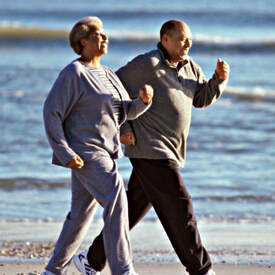Making the Most of Social Distancing
I was super frustrated with myself this week. I have plenty to do. But I’m cooped up in our house with three humans and six pets, and feeling perpetually tired. Ugh. What could I do to get my enthusiasm back?
Suddenly the light came on. I’ve wanted to start running again, and work my way back to the 10k days of my 30’s and 40’s. Granted, I’m now in my mid-60’s. Heavier, creakier. And also diabetic. Never mind, I could start slowly. And take a dog. (Not all three, I’m not completely nuts). By taking it slowly, I mean walking first. Increasing my distance and time. Then run/walking. Finally working up to running a few miles a day. Baby steps, and even if President Trump eliminates the social distancing in May--keep going.
By taking it slowly, I mean walking first. Increasing my distance and time. Then run/walking. Finally working up to running a few miles a day. Baby steps, and even if President Trump eliminates the social distancing in May--keep going.
You’ve probably heard that when it comes to slimming down, running beats walking. When you look at pure numbers, running certainly has an advantage. But the picture isn’t that black and white.
If a runner and walker, who each weigh 150 pounds, go out for a 30-minute run or walk, guess who’s going to burn more calories? Not surprisingly, the runner will—by about 170. If she’s running at a 10-minute-per-mile pace and the walker is striding along at a 15 minute-per-mile pace. Pretty black and white. But here’s the gray.
Can you walk out the door today and run at a 10-minute-per-mile pace for 30 minutes? Can you do this every day without any joint problems? If so, great! You’re probably already an avid runner. You’ll only want to walk on the days between runs, to allow your body to recover from the higher impact.
But if you, like me, don’t fit the example above today, and you want to burn the same number of calories, we have walking options. And – poof – the world has suddenly given us enough time to walk. You can walk for an hour a day. Or, you can pick up your pace to 4.5 mph (a 13:15 minute-per-mile pace), and you’ll be done in 42 minutes. Push it to 5mph (a 12-minute-per-mile pace), and you just have to go 6 minutes longer than the runner. Yes, that’s a speedy pace, but it’s possible if you work at it.
It requires more time to walk instead of run, but the amount of time—and turning your exercise into a daily habit—is probably more doable and more enjoyable than running, at least for those of us who no longer have 20-year-old legs and knees.
15 Reasons to Love Walking
 1.
1.
Walking offers instant benefits. You’ll feel happier and calmer. Worries and tension will ease. Cravings will diminish. A new study in the American Journal of Psychiatry suggests that 12% of depression cases could be prevented if we all walked (or did another form of exercise) for at least an hour a week. As you log more miles, your brain releases “happy” chemicals like serotonin and dopamine. This combo of chemicals can lift your mood during and after your workout. 2.
2.
The whole family can do it. One way or another. That includes pushing a stroller if necessary…more calorie burn for the parent!
3. Keep it up and you’ll fall asleep at bedtime—and stay asleep—more easily. 4. Your dogs will love you! Plus, they will be more engaged and will sleep better also.
4. Your dogs will love you! Plus, they will be more engaged and will sleep better also.
5. Walking helps you lose weight. The American Journal of Health Promotion found that women who increased their daily step count by 1,500 steps (about a half-mile mile) lost an average of 2 pounds over nine months. Now, imagine your results if you can hit 10,000 steps (about 6 miles) every day!
 6.
6.
You can exercise outside and soak up the vitamin D and sunshine while still social distancing. A recent study in the Journal of Sport & Psychology confirmed what we all know instinctively: Walking in the fresh air is more enjoyable than slogging around the track in a stuffy gym or stuck on a treadmill.
7.
Body aches and joint pain will subside. Just walking an hour per week acts as lube for creaky joints. Each step moves synovial fluid into and out of our joints and helps circulate nutrients to our cartilage to improve function.
8. Walking improves balance. Especially if you walk in sand or on an uneven surface. And remember to keep your head level and look at the trail ahead of you, not your feet. 9. If you are at risk for diabetes, walking can help you avoid the disease. Your pancreas, the gland located in your abdomen, produces digestive enzymes and hormones involved in regulating blood sugar. As you’re racking up your steps, your pancreas slows down production of insulin (the hormone that promotes fat storage), which increasing levels of the hormone glucagon. Glucagon pulls sugar out of storage so it can be used as fuel by muscles. If you follow a 30-minute-a-day walking habit, you could lower your diabetes risk by 30%. If you have diabetes (like me), keep walking, because it improves blood sugar control, and can help lower your A1C.
9. If you are at risk for diabetes, walking can help you avoid the disease. Your pancreas, the gland located in your abdomen, produces digestive enzymes and hormones involved in regulating blood sugar. As you’re racking up your steps, your pancreas slows down production of insulin (the hormone that promotes fat storage), which increasing levels of the hormone glucagon. Glucagon pulls sugar out of storage so it can be used as fuel by muscles. If you follow a 30-minute-a-day walking habit, you could lower your diabetes risk by 30%. If you have diabetes (like me), keep walking, because it improves blood sugar control, and can help lower your A1C.
10. Engaging in moderate physical activity, such as a brisk walk, for an hour or more a day may improve neuron health, according to a study in the Journal of Alzheimer’s Disease.
11. It builds stronger bones. Women who walk 4 hours or more a week lower their chances of hip fracture by more than 40%, the landmark Nurses’ Health Study found.
12. Walking strengthens your heart. Regularly walking 3 miles an hour or faster can cut your risk of heart disease by half. Note: Speed matters here. Walking at 2 mph or slower had less beneficial effect.
13. It stimulates your adrenal glands. These small yet powerful hormone producers lie on top of your kidneys and release adrenaline and noradrenaline as part of the fight or flight response that kicks in when you start walking. The hormones signal the heart to beat faster and stronger. As exercise continues and intensity rises, these glands release cortisol. While cortisol has been implicated in the storage of fat when you’re stressed out, under exercise conditions, it prompts the breakdown and release of fat from cells. 14. Phone time is walk time. So put on your sneakers and call a friend. Who says social distancing has to be torture? Make this time of hardship work for you as much as possible.
14. Phone time is walk time. So put on your sneakers and call a friend. Who says social distancing has to be torture? Make this time of hardship work for you as much as possible.
15. Follow the 10-minute rule. On days when you feel like you just can’t, compromise.
Walk for just 10 minutes. Don’t change your clothes, only your shoes. Simply set a time for 10 minutes and start walking. When the time goes off, you’re off the hook. You can stop if you want, without feeling guilty.
The National Weight Control Registry is a database of more than 10,000 people who have lost at least 30 pounds and kept it off for at least a year—but on average, participants have lost 71 pounds and kept it off for 6 years, with some losing as much as 300 pounds. When researchers investigated how these successful losers did it, they found that 94% of them increased physical activity. Guess what type of exercise was reported the most? Yes, walking.
I’m putting together my own daily walking routine, adding some fun variations and speeds to prevent boredom. I’m also charting out strength training routines to incorporate at least twice a week.
I’ll share my routine with you here next week.
Until then, step out for some social distance walking!
Blessed Be.
Suddenly the light came on. I’ve wanted to start running again, and work my way back to the 10k days of my 30’s and 40’s. Granted, I’m now in my mid-60’s. Heavier, creakier. And also diabetic. Never mind, I could start slowly. And take a dog. (Not all three, I’m not completely nuts).
 By taking it slowly, I mean walking first. Increasing my distance and time. Then run/walking. Finally working up to running a few miles a day. Baby steps, and even if President Trump eliminates the social distancing in May--keep going.
By taking it slowly, I mean walking first. Increasing my distance and time. Then run/walking. Finally working up to running a few miles a day. Baby steps, and even if President Trump eliminates the social distancing in May--keep going. You’ve probably heard that when it comes to slimming down, running beats walking. When you look at pure numbers, running certainly has an advantage. But the picture isn’t that black and white.
If a runner and walker, who each weigh 150 pounds, go out for a 30-minute run or walk, guess who’s going to burn more calories? Not surprisingly, the runner will—by about 170. If she’s running at a 10-minute-per-mile pace and the walker is striding along at a 15 minute-per-mile pace. Pretty black and white. But here’s the gray.
Can you walk out the door today and run at a 10-minute-per-mile pace for 30 minutes? Can you do this every day without any joint problems? If so, great! You’re probably already an avid runner. You’ll only want to walk on the days between runs, to allow your body to recover from the higher impact.
But if you, like me, don’t fit the example above today, and you want to burn the same number of calories, we have walking options. And – poof – the world has suddenly given us enough time to walk. You can walk for an hour a day. Or, you can pick up your pace to 4.5 mph (a 13:15 minute-per-mile pace), and you’ll be done in 42 minutes. Push it to 5mph (a 12-minute-per-mile pace), and you just have to go 6 minutes longer than the runner. Yes, that’s a speedy pace, but it’s possible if you work at it.
It requires more time to walk instead of run, but the amount of time—and turning your exercise into a daily habit—is probably more doable and more enjoyable than running, at least for those of us who no longer have 20-year-old legs and knees.
15 Reasons to Love Walking
 1.
1. Walking offers instant benefits. You’ll feel happier and calmer. Worries and tension will ease. Cravings will diminish. A new study in the American Journal of Psychiatry suggests that 12% of depression cases could be prevented if we all walked (or did another form of exercise) for at least an hour a week. As you log more miles, your brain releases “happy” chemicals like serotonin and dopamine. This combo of chemicals can lift your mood during and after your workout.
 2.
2. The whole family can do it. One way or another. That includes pushing a stroller if necessary…more calorie burn for the parent!
3. Keep it up and you’ll fall asleep at bedtime—and stay asleep—more easily.
 4. Your dogs will love you! Plus, they will be more engaged and will sleep better also.
4. Your dogs will love you! Plus, they will be more engaged and will sleep better also.5. Walking helps you lose weight. The American Journal of Health Promotion found that women who increased their daily step count by 1,500 steps (about a half-mile mile) lost an average of 2 pounds over nine months. Now, imagine your results if you can hit 10,000 steps (about 6 miles) every day!
 6.
6.You can exercise outside and soak up the vitamin D and sunshine while still social distancing. A recent study in the Journal of Sport & Psychology confirmed what we all know instinctively: Walking in the fresh air is more enjoyable than slogging around the track in a stuffy gym or stuck on a treadmill.
7.
Body aches and joint pain will subside. Just walking an hour per week acts as lube for creaky joints. Each step moves synovial fluid into and out of our joints and helps circulate nutrients to our cartilage to improve function.
8. Walking improves balance. Especially if you walk in sand or on an uneven surface. And remember to keep your head level and look at the trail ahead of you, not your feet.
 9. If you are at risk for diabetes, walking can help you avoid the disease. Your pancreas, the gland located in your abdomen, produces digestive enzymes and hormones involved in regulating blood sugar. As you’re racking up your steps, your pancreas slows down production of insulin (the hormone that promotes fat storage), which increasing levels of the hormone glucagon. Glucagon pulls sugar out of storage so it can be used as fuel by muscles. If you follow a 30-minute-a-day walking habit, you could lower your diabetes risk by 30%. If you have diabetes (like me), keep walking, because it improves blood sugar control, and can help lower your A1C.
9. If you are at risk for diabetes, walking can help you avoid the disease. Your pancreas, the gland located in your abdomen, produces digestive enzymes and hormones involved in regulating blood sugar. As you’re racking up your steps, your pancreas slows down production of insulin (the hormone that promotes fat storage), which increasing levels of the hormone glucagon. Glucagon pulls sugar out of storage so it can be used as fuel by muscles. If you follow a 30-minute-a-day walking habit, you could lower your diabetes risk by 30%. If you have diabetes (like me), keep walking, because it improves blood sugar control, and can help lower your A1C.10. Engaging in moderate physical activity, such as a brisk walk, for an hour or more a day may improve neuron health, according to a study in the Journal of Alzheimer’s Disease.
11. It builds stronger bones. Women who walk 4 hours or more a week lower their chances of hip fracture by more than 40%, the landmark Nurses’ Health Study found.
12. Walking strengthens your heart. Regularly walking 3 miles an hour or faster can cut your risk of heart disease by half. Note: Speed matters here. Walking at 2 mph or slower had less beneficial effect.
13. It stimulates your adrenal glands. These small yet powerful hormone producers lie on top of your kidneys and release adrenaline and noradrenaline as part of the fight or flight response that kicks in when you start walking. The hormones signal the heart to beat faster and stronger. As exercise continues and intensity rises, these glands release cortisol. While cortisol has been implicated in the storage of fat when you’re stressed out, under exercise conditions, it prompts the breakdown and release of fat from cells.
 14. Phone time is walk time. So put on your sneakers and call a friend. Who says social distancing has to be torture? Make this time of hardship work for you as much as possible.
14. Phone time is walk time. So put on your sneakers and call a friend. Who says social distancing has to be torture? Make this time of hardship work for you as much as possible.15. Follow the 10-minute rule. On days when you feel like you just can’t, compromise.
Walk for just 10 minutes. Don’t change your clothes, only your shoes. Simply set a time for 10 minutes and start walking. When the time goes off, you’re off the hook. You can stop if you want, without feeling guilty.
The National Weight Control Registry is a database of more than 10,000 people who have lost at least 30 pounds and kept it off for at least a year—but on average, participants have lost 71 pounds and kept it off for 6 years, with some losing as much as 300 pounds. When researchers investigated how these successful losers did it, they found that 94% of them increased physical activity. Guess what type of exercise was reported the most? Yes, walking.
I’m putting together my own daily walking routine, adding some fun variations and speeds to prevent boredom. I’m also charting out strength training routines to incorporate at least twice a week.
I’ll share my routine with you here next week.
Until then, step out for some social distance walking!
Blessed Be.
Published on April 07, 2020 19:56
No comments have been added yet.



